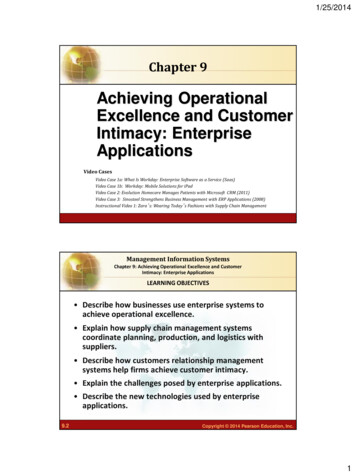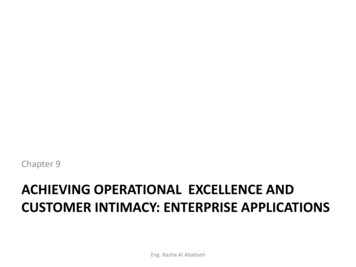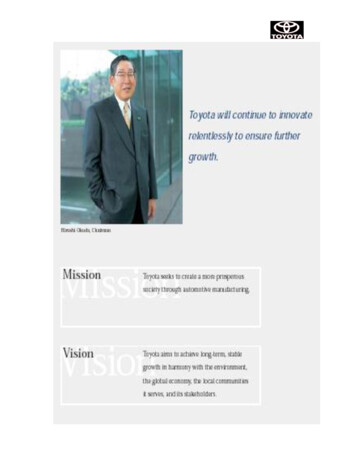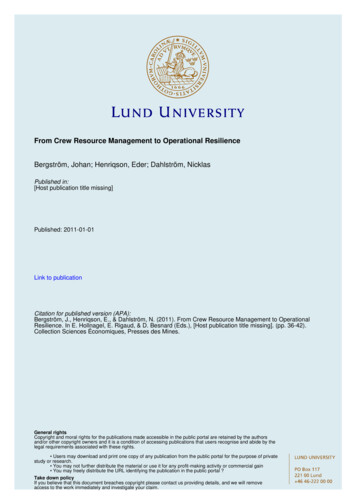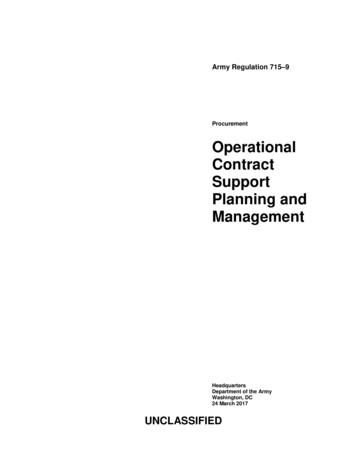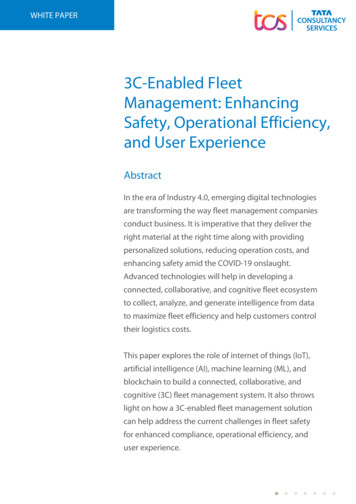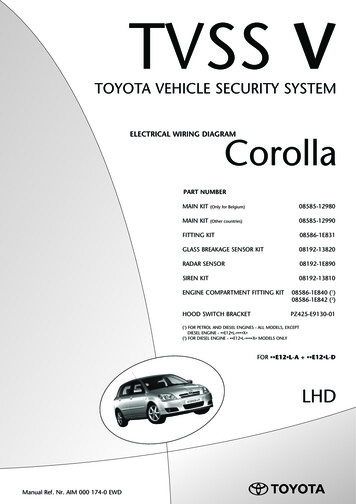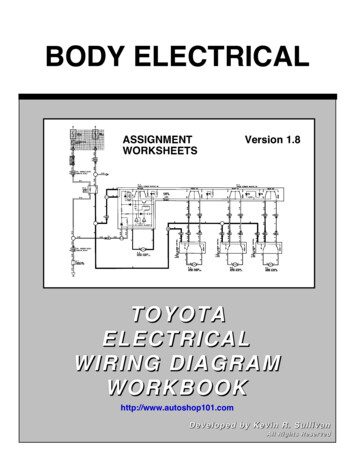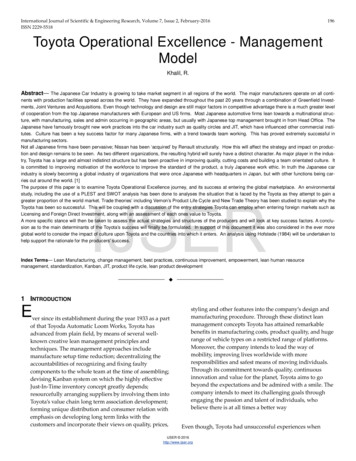
Transcription
International Journal of Scientific & Engineering Research, Volume 7, Issue 2, February-2016ISSN 2229-5518196Toyota Operational Excellence - ManagementModelKhalil, R.Abstract— The Japanese Car Industry is growing to take market segment in all regions of the world. The major manufacturers operate on all continents with production facilities spread across the world. They have expanded throughout the past 20 years through a combination of Greenfield Investments, Joint Ventures and Acquisitions. Even though technology and design are still major factors in competitive advantage there is a much greater levelof cooperation from the top Japanese manufacturers with European and US firms. Most Japanese automotive firms lean towards a multinational structure, with manufacturing, sales and admin occurring in geographic areas, but usually with Japanese top management brought in from Head Office. TheJapanese have famously brought new work practices into the car industry such as quality circles and JIT, which have influenced other commercial institutes. Culture has been a key success factor for many Japanese firms, with a trend towards team working. This has proved extremely successful inmanufacturing sectors.Not all Japanese firms have been pervasive; Nissan has been ‘acquired’ by Renault structurally. How this will affect the strategy and impact on production and design remains to be seen. As two different organizations, the resulting hybrid will surely have a distinct character. As major player in the industry, Toyota has a large and almost indistinct structure but has been proactive in improving quality, cutting costs and building a team orientated culture. Itis committed to improving motivation of the workforce to improve the standard of the product, a truly Japanese work ethic. In truth the Japanese carindustry is slowly becoming a global industry of organizations that were once Japanese with headquarters in Japan, but with other functions being carries out around the world. [1]The purpose of this paper is to examine Toyota Operational Excellence journey, and its success at entering the global marketplace. An environmentalstudy, including the use of a PLEST and SWOT analysis has been done to analyses the situation that is faced by the Toyota as they attempt to gain agreater proportion of the world market. Trade theories’ including Vernon’s Product Life Cycle and New Trade Theory has been studied to explain why theToyota has been so successful. This will be coupled with a discussion of the entry strategies Toyota can employ when entering foreign markets such asLicensing and Foreign Direct Investment, along with an assessment of each ones value to Toyota.A more specific stance will then be taken to assess the actual strategies and structures of the producers and will look at key success factors. A conclusion as to the main determinants of the Toyota’s success will finally be formulated. In support of this document it was also considered in the ever moreglobal world to consider the impact of culture upon Toyota and the countries into which it enters. An analysis using Hofstede (1984) will be undertaken tohelp support the rationale for the producers’ success.IJSERIndex Terms— Lean Manufacturing, change management, best practices, continuous improvement, empowerment, lean human resourcemanagement, standardization, Kanban, JIT, product life cycle, lean product development—————————— ——————————1 INTRODUCTIONEver since its establishment during the year 1933 as a partof that Toyoda Automatic Loom Works, Toyota hasadvanced from plain field, by means of several wellknown creative lean management principles andtechniques. The management approaches includemanufacture setup time reduction; decentralizing theaccountabilities of recognizing and fixing faultycomponents to the whole team at the time of assembling;devising Kanban system on which the highly effectiveJust-In-Time inventory concept greatly depends;resourcefully arranging suppliers by involving them intoToyota’s value chain long term association development;forming unique distribution and consumer relation withemphasis on developing long term links with thecustomers and incorporate their views on quality, prices,styling and other features into the company’s design andmanufacturing procedure. Through these distinct leanmanagement concepts Toyota has attained remarkablebenefits in manufacturing costs, product quality, and hugerange of vehicle types on a restricted range of platforms.Moreover, the company intends to lead the way ofmobility, improving lives worldwide with moreresponsibilities and safest means of moving individuals.Through its commitment towards quality, continuousinnovation and value for the planet, Toyota aims to gobeyond the expectations and be admired with a smile. Thecompany intends to meet its challenging goals throughengaging the passion and talent of individuals, whobelieve there is at all times a better wayEven though, Toyota had unsuccessful experiences whenIJSER 2016http://www.ijser.org
International Journal of Scientific & Engineering Research, Volume 7, Issue 2, February-2016ISSN 2229-5518establishing an independent manufacturing subsidiarywithin California with the aim to get hold of the smallvehicle market within the USA, the firm improved inquality to match the local conditions and in effect made atriumphal turnaround within the United States marketduring the late 1960s [3]. Additionally, following the rise inoil price unpredictably increased the demand for Toyota’svehicles that are fuel saving and light. Since that time, theglobal exporting trade of Toyota has seen a sound growth.To deal with the import barriers like local content rulesand import quotas, the company formed a 50/50 jointventure i.e. New United Motor Manufacturing, Inc. withGeneral Motor within USA during 1983 . It also formed awholly owned production unit in the UK during 1989 andanother in France during 1997. Toyota also formed a 50/50joint venture along with French automaker Peugeot withinthe Czech Republic during 2002. Moreover, bold strideshave also been taking place in China; at present the globe’sfastest growing vehicle market. Currently, Toyota hasturned out to be the biggest car producer worldwideoffering employment opportunities to over 320,808individuals. As of 2010, the company had 52 productionunits located in 26 distinct countries apart from in Japan,about 12 product designs as well as research anddevelopment units in 7 nations. [3]197Table 1: Brief PlEST Analysis of Automotive Industry2.2 SWOT AnalysisToyota has achieved a high market share of the world’s automotive industry, and this is predominantly down to the factthat Toyota’s production techniques are as good as any in theworld. [16]Table 2: Brief SWOT Analysis of ToyotaIJSER2 TOYOTA INDUSTRIAL ENVIRONMENT BEST PRACTICESToyota has big business throughout the world, and the environment in which it takes place is ever changing, below is ashort synopsis of both a full PLEST and SWOT analysis. ThePLEST has been piloted in relation to the industry environment as a whole and also with respect to the Japanese environment, whereas the SWOT is specific to Toyota and beengenerated in the Toyota Production System. [1]2.1 PLEST AnalysisToyota has seen various forms of barriers restricting both entryfrom new competitors into the industry and also trade between countries, such as tariffs and duties, which have intimes past slowed down Toyota. It is at risk to many of theeconomic dilemmas that other industries experience such asrecession and high inflation, but also has to more specificproblems such as oil crisis. [2] With Europe and the UnitedStates being large markets, cultural concerns become evident;consumer tastes and management styles vary throughout theworld and must consequently be considered by Toyota whenthey enter markets. Another important factor is technology;which is extremely important in the automobile industry,many of the competitors are highly technologically innovative.An analysis of these factors can be viewed briefly below.In fact TPS has been set as a standard procedures or best practices in service and manufacturing sectors. Toyota has struggled however, to really become dominant in Europe, and haveeven had their designs branded as “uninteresting”. The relaxation of legislation and trade barriers has and indeed will allow Toyota to enter more markets more easily than was previously possible. Of course the firm must beware of competitorsattempting to imitate their vehicles, after all this is how theJapanese entered the market initially. They must also take careIJSER 2016http://www.ijser.org
International Journal of Scientific & Engineering Research, Volume 7, Issue 2, February-2016ISSN 2229-5518198not to ignore the growing environmental awareness of consumers and keep up with fashion. [4]Toyota started in 1933 as a division of Toyoda AutomaticLoom Works devoted to the production of automobiles underthe direction of the founder's son, Kiichiro Toyoda. It soldaround 8 million units globally in 2008; Toyota's sales surpassed General Motors, making Toyota number .one in theworld. As this market expands, Toyota concentrates more on aclose relationship with its customers rather than viewing sizeas key to survival. [2] Raymond Vernon’s, the product lifecycle theory searched for an explanation why many newproducts were developed and sold first in the U.S during the20th century. However, as demand increased for the products,competitors entered the market and the original firm wasforced to try and cut costs. Together with demand for theproduct increasing abroad, this often meant the firm would setup production abroad, taking advantages of factors such aslower labour costs. In years to follow, the U.S would end upimporting the very product it invented. [6]Figure 1: Vernon’s Product Life CycleExportsConsumptionImportsProductionWithin the automobile industry, absolute advantage wasevident through the US being the innovators of the productlines, yet Japan, with collectivism and a manufacturing focussed employee, succeeded to improve on American techniques. This is why Japan has such a significant share of themarket. The new trade theory emerged from a number ofeconomists during the 1970s. [7] It argues that specialisation inthe production and export of certain goods is not due to underlying differences in factor endowment but because theworld market only has the capacity to support a limited number of firms in some industries. As Toyota moved into the automobile market internationally, quick adaptations of strategymeant that they were successful as early entrants. Economiesof scale and learning economies are the first-mover advantagesthat discourage new entrants into the market, after Toyotasimpressive entrance. Regarding competitive advantage, thistheory looks at the four characteristics in figure below. Porterstates that these characteristics of a nation mould the environment in which local firms compete. They may either promote or impede the notion of competitive advantage. As illustration in figure 5 [1,2]IJSERThis theory in terms of the automobile industry becomes awell proven practice in automotive, aerospace, healthcare andother sectors. The US were firm leaders of the market until theJapanese adapted ideas from the British and American carproducers in the 1960’s, and then offered a superior yet cheaper product. This is why Japan used to import so many automobiles yet now has more of an advantage on exportation.The graph below shows a rough portrayal for developed country, such as Japan, on how, regarding a new product, consumption and production rates develop. [8]Figure 3: Porter’s Diamond TheoryTable 3: Porter’s Theory in ToyotaFigure 2: Advanced Countries Product Life CycleIJSER 2016http://www.ijser.org
International Journal of Scientific & Engineering Research, Volume 7, Issue 2, February-2016ISSN 2229-5518199Note: Above Analysis done for research purposea.3 CROSS-CULTURAL DIFFERENCES AND STYLES OFMANAGEMENTCorporate culture can be said that collective behaviour andassumptions that are taught to all the organizational membersand this particular culture has an effect on the people andgroups, stakeholders etc. it is important for all companies developing a corporate culture to bind the organization, its philosophy and the employees together. Toyota is no exception.As Toyota is a very big company and they keep expandinginternationally. [9]They set up their units and headquarters indifferent parts of the world. So it is important for the companyto have an in-depth understanding of the world cultures. According to Hofstede (1984) Culture is “the collective programming of the mind, which distinguishes the members ofone category of people from another”. As we can see fromFigure 8.1 there are several determinants to what culture isand how norms and value systems are developed. Hofstede,through his research into culture, developed his 5 indices todefine culture. The key points are outlined below: [1]b.c.Power Distance Index (PDI) focuses on the degreeof equality, or inequality, between people in thecountry's society. [11]Individualism (IDV) focuses on the degree the society reinforces individual or collective achievement and interpersonal relationships.Masculinity (MAS) focuses on the degree the society reinforces, or does not reinforce, the traditionalmasculine work role model of male achievement,control, and power. [10]Uncertainty Avoidance Index (UAI) focuses on thelevel of tolerance for uncertainty and ambiguitywithin the society - i.e. unstructured situations.Long-Term Orientation (LTO) focuses on the degree the society embraces, or does not embracelong-term devotion to traditional, forward thinkingvalues.IJSERFigure 4: Culture Categorizationd.e.4 INTERNATIONAL BUSINESS STRATEGYToyotas production has declined in its home country over thepast ten years; this is due to the deliberate decision by Japanese manufact
The purpose of this paper is to examine Toyota Operational Excellence journey, and its success at entering the global markeplace. An environmental t study, including the use of a PLEST and SWOT analysis has been done to analyses the situation that is faced by the Toyota as they attempt to gain a greater proportion of the world market. Trade theories’ including Vernon’s Product Life C ycle and File Size: 1MBPage Count: 7

